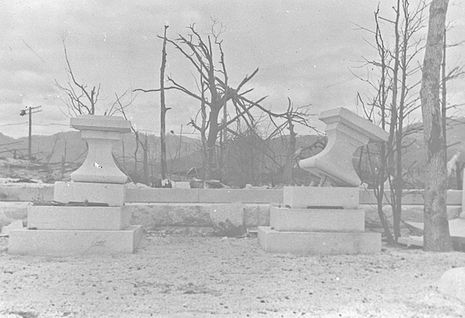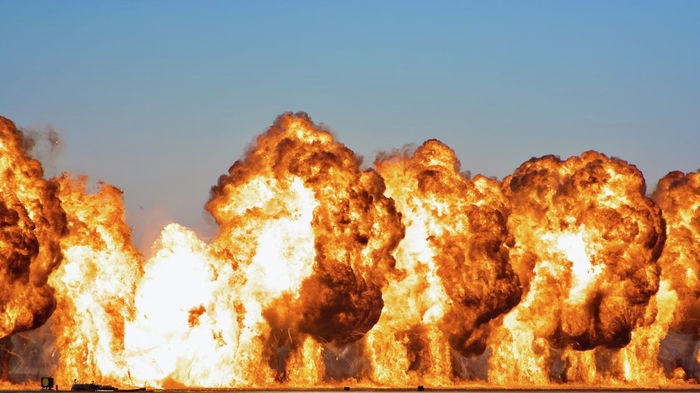Where are the victims in Oppenheimer?
Min-Kyoo Kim considers the ethical implications of representing nuclear fallout in Christopher Nolan’s latest film

Oppenheimer has soared to $400 million (and counting) in box-office receipts – fuelled, perhaps, by the meme fusion of ‘Barbenheimer’ – while attaining glowing critical reviews, praising everything from Christopher Nolan’s direction and the ensemble performances to Ludwig Göransson’s pulsating soundtrack. By these metrics, the film is proving a stellar success. And yet, Oppenheimer has encountered criticism for its perceived lack of engagement with the victims of the atomic bombings in Japan at the end of the Second World War. Eileen Jones, writing for Jacobin, argues that “the absolute lack of physical reality given to the results of dropping atomic bombs on Hiroshima and Nagasaki … is one of the film’s more stunning glossing-over effects.”
Indeed, despite its three-hour runtime, there remain absences and elisions in the film’s coverage of the Manhattan Project. While Matt Damon’s Leslie Groves boasts of the procurement of 12,000 tonnes of uranium, he bears no mention of its provenance in the colonial setting of the Belgian Congo. Equally, the film shows only a fleeting concern for the downwinders of the Trinity test, and the aftereffects of the atomic bombings in Hiroshima and Nagasaki are obscured in a slideshow projected off-screen, its images so appalling that even Oppenheimer himself averts his gaze from them.
“the horrors experienced by those we do not or cannot see”
But such oblique visions of nuclear apocalypse do not necessarily constitute failures – be they moral, narrative or aesthetic – of cinematic representation. To experience the atomic bomb within its blast radius was to be exposed to, and incinerated by, the temperature of the Sun’s surface. In the wake of this blinding atomic detonation in Hiroshima, the photographer Yoshito Matsushige sought to document the scenes around him. He later recalled: “I felt so sorry for these dead and naked people … I walked through the section of town which had been hit hardest. I walked for close to three hours. But I couldn’t take even one picture of that central area.”
Oppenheimer’s concern is not to occupy this absence – nor should it be. Simply put, the story of the hibakusha (‘bomb-affected people’) is not Christopher Nolan’s to depict. There is no IMAX screen that could ever provide a complete picture of the devastation in Hiroshima and Nagasaki. If you want the first-hand experiences of the hibakusha, there are other places to look – read their testimonies in John Hershey’s Hiroshima (1946) and listen to their ongoing anxieties and protests about nuclear proliferation in our own day and age. And just remember that certain victims left behind not stories, but literal shadows of themselves. These ghostly reminders oblige us to acknowledge the horrors experienced by those we do not or cannot see, those that Yoshito Matsushige could not bear to picture.
“The scene becomes a virtuosic depiction of madness”
In light of this, Oppenheimer’s objective is not to visualise an unimaginable atrocity, but to focus on the psychology behind its perpetration. When Oppenheimer addresses an adulatory crowd after the news of the bombings, we confront the foot-stamping, Bacchic jubilation of an American public intoxicated by the triumphs of nuclear power. Here, Nolan mobilises his full arsenal of cinematic techniques. The very fabric of the screen vibrates with the deafening roar of the crowd, as they cheer the dropping of the atomic bomb as they would a basketball dunk – a sporting metaphor anchored in the image of a hoop hanging like a halo over Oppenheimer’s podium. The thunderous applause of the crowd builds to a crescendo, a soundscape that shakes not only the rafters of the auditorium, but our very senses. The scene becomes a virtuosic depiction of madness, of a society’s jingoistic death-drive towards mutual assured destruction.
Oppenheimer’s critique of militarism proves that the absence of hibakusha does not constitute an abdication of moral responsibility on Nolan’s behalf. Far from it. What terrified me the most about the sight and sound of the enraptured auditorium is how it compels us today – in the analogous space of the cinema – to reflect on our continuing social and political commitment to nuclear weapons. The majority of respondents in a recent survey demonstrated support for the renewal of the U.K.’s nuclear deterrent, Trident. Britain – or indeed, any other nuclear power – is yet to sign the U.N.’s Treaty on the Prohibition of Nuclear Weapons, which came into effect in 2021. With the failures of arms control amid the war in Ukraine, the Bulletin for Atomic Scientists – founded by members of the Manhattan Project – have set the Doomsday Clock at the closest to midnight that it’s ever been. This is the ethical strategy of Oppenheimer, to show that we stand on the precipice of its pessimistic, concluding vision of nuclear catastrophe – of a world in which there can be no victors, only victims.
Min-Kyoo Kim is currently studying for a PhD in Film Studies, researching cinematic representations of nuclear power. Oppenheimer is in UK cinemas now.
 News / Cambridge postgrad re-elected as City councillor4 May 2024
News / Cambridge postgrad re-elected as City councillor4 May 2024 News / Gender attainment gap to be excluded from Cambridge access report3 May 2024
News / Gender attainment gap to be excluded from Cambridge access report3 May 2024 News / Some supervisors’ effective pay rate £3 below living wage, new report finds5 May 2024
News / Some supervisors’ effective pay rate £3 below living wage, new report finds5 May 2024 News / Academics call for Cambridge to drop investigation into ‘race realist’ fellow2 May 2024
News / Academics call for Cambridge to drop investigation into ‘race realist’ fellow2 May 2024 Comment / Accepting black people into Cambridge is not an act of discrimination3 May 2024
Comment / Accepting black people into Cambridge is not an act of discrimination3 May 2024





